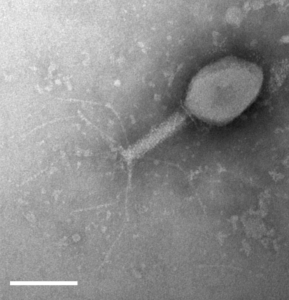Current Fellow Tim Blower publishes new paper revealing discovery of new family of BREX phage defence system regulators

Last week, Tim Blower published the findings from his Lister-funded research in Nucleic Acids Research: A widespread family of WYL-domain transcriptional regulators co-localizes with diverse phage defence systems and islands.
This paper details his lab’s discovery of a new family of regulators that control the expression of their model BREX phage defence system – BrxR.
They subsequently identified that this family is widespread throughout bacteria and appears to be a global regulator of diverse phage defence systems, from BREX and CRISPR-cas, to CBASS and restriction-modification systems. BrxR has a WYL-domain that likely allows sensing of phage infection and upregulation of phage defence.
“Discovering the new family of BrxR proteins demonstrates that phage defence systems, which include key biotechnological tools such as CRIPSR-cas and restriction-modification, are tightly controlled across bacteria.”
Tim continues: “This is likely to prevent any toxic effects to the host before activation, whilst ensuring a measured and well-timed defence against infection.
“Even more exciting is the prospect of finding new types of phage defence system based on their proximity to BrxR-family genes. We’ll now be trying to identify and characterise new defence systems, whilst building detailed molecular models for BrxR activity during phage infections.”

Towards the end of 2021, we reported on Tim’s paper – also published in Nucleic Acids Research – which identified two cooperative defence systems that protect bacteria from a broad range of phages.
The Blower Lab’s paper is published back-to-back with related papers from the labs of Brett Kaiser and Barry Stoddard (Identification and characterization of the WYL BrxR protein and its gene as separable regulatory elements of a BREX phage restriction system) and from Kevin Corbett’s lab (Control of bacterial immune signaling by a WYL domain transcription factor) who made similar, complementary, discoveries.
We wish Tim and his team the very best of luck with their ongoing research.
Lister members join Royal Society as 2022 Fellows
May is the time of year when the esteemed Royal Society announce their list of new Fellows.
This year, 60 exceptional scientists were awarded the privilege in response to their ‘outstanding contributions to science’. We were very pleased to see two individuals associated with the Lister become Fellows of this prestigious institution.

Professor Kate Storey, a former member of our Scientific Advisory Committee, was elected due to her ‘seminal’ discoveries about the embryonic development of the vertebrate spinal cord. Kate is currently Head of the Division of Cell and Developmental Biology at the School of Life Sciences, University of Dundee.

Former Lister Fellow Professor Paul Lehner also became a Royal Society Fellow, thanks to his work on the HUSH complex. We wrote about his research into how HUSH defends the human genome from retroelement attack in a news article earlier this year. Paul is currently Professor of Immunology and Medicine at the Cambridge Institute of Therapeutic Immunology and Infectious Disease, University of Cambridge.
We send our warmest congratulations to them both.



